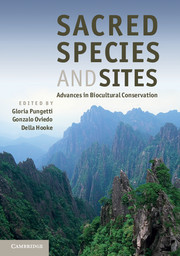Book contents
- Frontmatter
- Contents
- List of Contributors
- Foreword
- Preface
- Acknowledgements
- Introduction
- Part I Concepts and Knowledge
- Part II Sacred Landscapes
- Part III Sacred Sites and People
- Part IV Sacred Species
- Part V Sacred Animals
- Part VI Sacred Groves and Plants
- Part VII Implementation and Conclusions
- 25 Sacred species and biocultural diversity: applying the principles
- 26 Sacred sites, sacred landscapes and biocultural diversity: applying the principles
- 27 Conclusions: the journey to biocultural conservation
- 28 Epilogue: a Spiritual Circle
- Index
- Plate Section
- References
25 - Sacred species and biocultural diversity: applying the principles
from Part VII - Implementation and Conclusions
Published online by Cambridge University Press: 05 August 2012
- Frontmatter
- Contents
- List of Contributors
- Foreword
- Preface
- Acknowledgements
- Introduction
- Part I Concepts and Knowledge
- Part II Sacred Landscapes
- Part III Sacred Sites and People
- Part IV Sacred Species
- Part V Sacred Animals
- Part VI Sacred Groves and Plants
- Part VII Implementation and Conclusions
- 25 Sacred species and biocultural diversity: applying the principles
- 26 Sacred sites, sacred landscapes and biocultural diversity: applying the principles
- 27 Conclusions: the journey to biocultural conservation
- 28 Epilogue: a Spiritual Circle
- Index
- Plate Section
- References
Summary
Introduction
Over the past 10000 years of settled agriculture, humans have changed the Earth's landscape. We have converted forests into farmlands, reclaimed wetlands for agriculture and planted woodlots in savannas, transforming natural landscapes into cultural ones. In the process, we have also changed the habitats of 1.8 million other known species that we share this planet with (EOL, 2008). However, during this time we have also domesticated many species by creating new habitats for them. These include a wide variety of grasses that we use for cereal grains, a number of trees that yield valuable non-timber forest products and a variety of animals for milk and meat. Furthermore, in search of useful products, humans have altered the species composition of the so-called ‘natural’ landscapes. For example, the Kayapo Indians of the Brazilian Amazon are known to have maintained Brazil nut groves, altering the species composition of forest they inhabited (Posey, 1985). Similarly, many indigenous societies across the world have favoured a variety of other useful species, giving rise to landscape-scale heterogeneity. In Kebon Tatangkalan agroforests of West Java, Indonesia, for example, Parikesit et al. (2005) identified 12 different types of tree assemblages. Such traditional land-use practices have not only given rise to landscape-scale heterogeneity, but they have made a contribution to the biocultural diversity of our planet.
Although domestication has been an important driving force in creating new habitats for some species, the reasons for conservation of many others may not just be utilitarian. It can be argued that the origins of biocultural diversity have as much to do with the veneration of species as with their usefulness, as the examples below suggest. Near the town of Madurai, in the Tamilnadu state of India, tree groves provide roosting sites for colonies of the Indian flying fox (Pteropus giganteus). It is believed that this bat, which elsewhere is hunted for its body fat, receives protection because the trees are worshipped by the local people (Marimuthu, 1988).
- Type
- Chapter
- Information
- Sacred Species and SitesAdvances in Biocultural Conservation, pp. 367 - 406Publisher: Cambridge University PressPrint publication year: 2012
References
- 1
- Cited by



